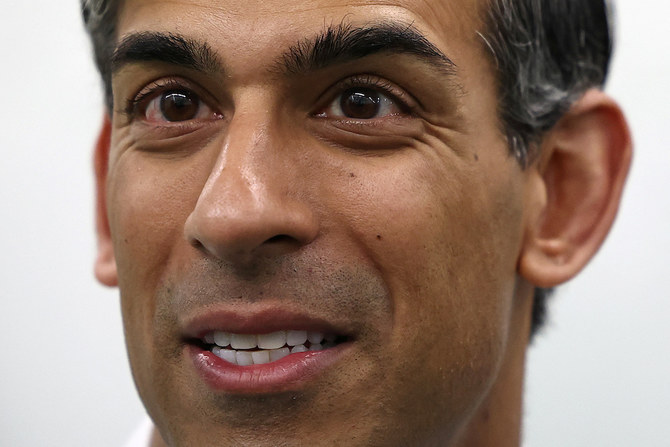Andrew Hammond
When Rishi Sunak became UK prime minister in 2022, the conventional wisdom was that he would help stabilize a flailing government, even if the ruling Conservatives were turfed out of office at the general election. However, next month could bring about another political meltdown, with a possible third change of prime minister in the same Parliament.
The trigger point for this possible next phase of political turmoil could come with the May 2 local elections. In last year’s equivalent ballots, the Conservatives for the first time in over two decades lost the mantle as the biggest party in English councils, and this rout looks likely to continue next month.
If the Conservatives lose big, it will only intensify the political pressure on the prime minister’s position. This could see a leadership challenge within his party.
Under present rules, such a challenge could be triggered if only 15 percent of Conservative MPs write to express lack of confidence in Sunak’s leadership. At that point, there would then be a secret ballot of those legislators, with a simple majority needed for victory on either side.
If Sunak loses, a leadership election would begin in which he cannot stand. However, if he wins, he would lead the party into the general election, as another internal Conservative contest cannot be triggered for another year.
The most recent Conservative no-confidence vote came in 2022. Although Boris Johnson won the contest with almost 60 percent support from his party’s MPs, he was badly wounded, and ultimately forced to resign as prime minister weeks later.
A much less likely, but still plausible, scenario is that Sunak faces a House of Commons no-confidence vote. To govern, a prime minister has to have the confidence of the majority of the House, which should be the case given the significant Conservative majority.
To test this proposition, a motion of no confidence could be moved by the opposition Labour leader Keir Starmer to be voted on by all MPs, regardless of which party they represent. No-confidence motions can be on key pieces of legislation which the government regards as so important that it will potentially stand or fall on them.
The last time a government was defeated this way was in 1979. The then-Labour government under Prime Minister James Callaghan lost a confidence vote, which resulted in a general election being called, leading to Margaret Thatcher’s premiership.
It is in this troubled context that Sunak, often politically cautious, may decide to take a chance and call a summer election for June or July. There has been some speculation that King Charles, who constitutionally has to give permission to the prime minister to dissolve Parliament, might refuse.
The king could, in theory, act in this way if there is another party leader, another party, or a coalition of parties that is ready and able to govern. However, since Parliament is approaching the end of the five-year limit, it is improbable the king would block an election.
One variant of these scenarios is that Sunak simply decides he has had enough and quits. While this is unlikely, too, 2022 saw two such prime ministerial resignations from Johnson, and also Liz Truss amid the controversy over her mini-budget.
The reason why a resignation, allowing another Conservative to stand as prime minister, cannot be entirely ruled out is Sunak’s present exasperation. Since he assumed office, he has made numerous political reboots, thousands of policy announcements, but nothing has fundamentally changed the UK’s political weather.
In part, this is because the intellectual climate is shifting toward Labour, with many voters increasingly recognizing the poor state of public services, and that further investment is needed in them. Many think tanks, including the independent Institute of Fiscal Studies, have particularly highlighted the challenges facing the health service.
According to the most recent Electoral Calculus forecasts, based on latest opinion surveys, the probability of a Labour majority in the House of Commons is 95 percent. Meanwhile, the likelihood of Labour being the largest party is 99 percent. While polls may tighten in coming weeks, the direction of travel appears clear.
Almost a decade and a half since the Conservatives first took power in 2010, and five prime ministers later via David Cameron, Theresa May, Boris Johnson, Liz Truss, and now Sunak, the party looks increasingly tired and divided. This is shown in the growing numbers of the party’s MPs to announce their retirement from politics — well over 60, at the time of writing.
History shows that Sunak and other recent “tail-end” prime ministers — beleaguered politicians who come into office at the end of a long period of rule by their parties — tend to want to put off big ballots as long as possible. This was true of previous Conservative Prime Ministers Alec Douglas-Home and John Major, who called the ballots in 1964 and 1997, respectively, close to the last possible legal date.
Despite the huge diversity of tail-end premiers in backgrounds, beliefs and styles, a common pattern is that they ultimately prove unable to stop the flow of the political tide. After multiple years in office, there is growing momentum for the opposition party that eventually proves insurmountable.
Taken together, Sunak’s attempt to win a fifth straight term for the Conservatives would defy political history, and it appears most unlikely that the government will be able to regain sustained, significant political momentum.
As May 2 approaches, his premiership is perilously positioned, with a growing possibility he may not lead the party into the general election.







